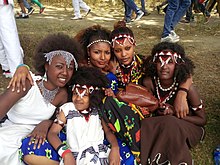Pobo oromo
Os oromo (en oromo: Oromoo) son un grupo étnico cuxita que habita na rexión de Oromia, en Etiopía. É un dos meirandes grupos étnicos de Etiopía e representa o 34,5% da poboación do país.[8] Os oromo falan a lingua oromo como lingua materna (tamén chamada afaan oromoo e oromiffa), que forma parte da póla cuxita das linguas afroasiáticas. A verba oromo apareceu na literatura europea por vez primeira en 1893 e pouco a pouco fíxose común na segunda metade do século XX.[9][10]
| Pobo oromo | |
|---|---|
 Mulleres oromo. | |
| Poboación | |
| Poboación total: c 33 millóns | |
| Rexións principais: | |
| 32 500 000 (2007)[1] | |
| 470 700 (2019)[2] | |
| 87 000[3] | |
| 2 030 (2014)[4] | |
| 3 350 (2016)[5] | |
| Aspectos culturais | |
| Lingua | Lingua oromo |
| Relixión | ~ 67% islam[6] ~ 33% Igrexa etíope[6] |
| Grupos relacionados | Afar • Agaw • Tigriña • Beja • Beta Israel • Bilen • Gurage • Jeberti • Saho • Somalí • Tigré • e outros pobos semíticos e cuxitas[7] |
Outrora, os oromo practicaban a súa relixión tradicional[11] e empregaban o sistema gadaa de goberno.[12][13] Un líder elixido polo sistema gadaa permanecía no poder só durante 8 anos, despois do cal se facían eleccións.[14][15][16] Durante os séculos XVIII e XIX, os oromo foron o grupo dominante do norte de Etiopía no período Zemene Mesafint. Foron protagonistas de grandes migracións históricas, e de guerras cos cristiáns do norte e cos musulmáns do sur e do leste no Corno de África.[17][18][19]
Notas editar
- ↑ Central Statistical Agency, Ethiopia. Summary and Statistical Report of the 2007 Population and Housing Census Results, ed. "Table 2.2 Percentage Distribution of Major Ethnic Groups: 2007" (PDF). United Nations Population Fund. p. 16. Arquivado dende o orixinal (PDF) o 25 de marzo de 2009. Consultado o 29 de outubro de 2014.
- ↑ Kenya National Bureau of Statistics (ed.). "Population and Housing Census: Ethnic Affiliation". knbs.or.ke. Arquivado dende o orixinal o 12 de maio de 2013. Consultado o 21 de maio de 2019.
- ↑ Project, Joshua. "Oromo, Southern in Somalia" (en inglés). Consultado o 7 de novembro de 2018.
- ↑ "Australian Bureau of Statistics 2014, The People of Australia Statistics from the 2011 Census, Cat. no. 2901.0, ABS, 30 de novembro de 2016," (PDF). Arquivado dende o orixinal (PDF) o 17 de abril de 2017. Consultado o 22 de xullo de 2019.
- ↑ "Archived copy". Arquivado dende o orixinal o 23 de setembro de 2017. Consultado o 29 de xaneiro de 2018.
- ↑ 6,0 6,1 James B. Minahan (2016). Encyclopedia of Stateless Nations: Ethnic and National Groups around the World, 2nd Edition. ABC-CLIO. pp. 319–320. ISBN 978-1-61069-954-9.
- ↑ Joireman, Sandra F. (1997). Institutional Change in the Horn of Africa: The Allocation of Property Rights and Implications for Development. Universal-Publishers. p. 1. ISBN 1581120001.
- ↑ Ethiopia: People & Society Arquivado 23 de febreiro de 2011 en Wikiwix, CIA Factbook (2016)
- ↑ Tesema Ta'a (2006). Otto Harrassowitz Verlag, ed. The Political Economy of an African Society in Transformation: the Case of Macca Oromo (Ethiopia). pp. 17–19 with footnotes. ISBN 978-3-447-05419-5.
- ↑ Mohammed Hassen (2015). Boydell & Brewer (Originally: Cambridge University Press), ed. The Oromo and the Christian Kingdom of Ethiopia: 1300-1700. pp. 2–3. ISBN 978-1-84701-117-6.
- ↑ Donald N. Levine (2014). University of Chicago Press, ed. Greater Ethiopia: The Evolution of a Multiethnic Society. pp. 35–41. ISBN 978-0-226-22967-6.
- ↑ "Gada system, an indigenous democratic socio-political system of the Oromo - intangible heritage - Culture Sector - UNESCO". ich.unesco.org (en inglés). Consultado o 30 de maio de 2018.
- ↑ Harold G. Marcus A History of Ethiopia. University of California Press (1994) pp. 55 Google Books
- ↑ John Ralph Willis (2005). Slaves and Slavery in Africa: Volume Two: The Servile Estate. Routledge. pp. 122–127, 129–134, 137. ISBN 978-1-135-78017-3.
- ↑ John Ralph Willis (2005). Routledge, ed. Slaves and Slavery in Africa: Volume Two: The Servile Estate. pp. 128–134. ISBN 978-1-135-78016-6.
- ↑ Ira M. Lapidus (2014). A History of Islamic Societies. Cambridge University Press. p. 483. ISBN 978-1-139-99150-6.
- ↑ Richard Pankhurst (1997). The Ethiopian Borderlands: Essays in Regional History from Ancient Times to the End of the 18th Century. The Red Sea Press. pp. 279–280. ISBN 978-0-932415-19-6.
- ↑ Mohammed Hassen, Conquest, Tyranny, and Ethnocide against the Oromo: A Historical Assessment of Human Rights Conditions in Ethiopia, ca. 1880s–2002 , Northeast African Studies Volume 9, Number 3, 2002 (New Series)
- ↑ Arne Perras (2004). Oxford University Press, ed. Carl Peters and German Imperialism 1856-1918: A Political Biography. pp. 154–157. ISBN 978-0-19-926510-7.
Véxase tamén editar
| Wikimedia Commons ten máis contidos multimedia na categoría: Pobo oromo |
Bibliografía editar
- Donald N. Levine (2014). Greater Ethiopia: The Evolution of a Multiethnic Society. University of Chicago Press. ISBN 978-0-226-22967-6.
- Tsega Etefa, Integration and Peace in East Africa: A History of the Oromo Nation. Nova York: Palgrave Macmillan, 2012. ISBN 978-0-230-11774-7
- Mohammed Hassan, The Oromo of Ethiopia, A History 1570–1860. Trenton: Red Sea Press, 1994. ISBN 0-932415-94-6
- Herbert S. Lewis. A Galla Monarchy: Jimma Abba Jifar, Ethiopia 1830–1932. Madison: The University of Wisconsin Press, 1965.
- INS Resource Information Center (ed.). "RIC Query – Ethiopia". Arquivado dende o orixinal o 01 de novembro de 2005. Consultado o 8 de outubro de 2005.
- Temesgen M. Erena, Oromia: 'Civilisation, Colonisation And Underdevelopment, Oromia Quarterly, No.1, xullo de 2002, ISSN 1460-1346.